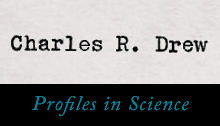Education
Higher Education Modules
Life after Death: Dr. Charles Drew, Civil Rights, and the Legacy of Race
Class 1: War and Science
Introduction
This first class includes secondary readings for understanding medical research during the Second World War. The American soldier’s greatest threat has been disease, illness, and bacterial infection from combat wounds inflicted during battle. Wartime production of penicillin and other antibiotics allowed physicians to fight a host of clinical diseases that long plagued soldiers and civilians. At the same time, the federal government and research universities began mobilizing a broad-based war against disease that included exposing and eradicating an array of disease populations during the war and post-war period.
Readings:
Brandt, Allan M. No Magic Bullet: A Social History of Venereal Disease in the United States Since 1880. New York: Oxford University Press, 1987, pp. 161-177.
Leys-Stepan, Nancy. Eradication: Ridding the World of Diseases Forever? Ithaca: Cornell University Press, 2011, pp. 105-111.
Ludmerer, Kenneth M. Time to Heal: American Medical Education from the Turn of the Century to the Era of Managed Care. New York: Oxford University Press, 1999, pp. 125-135.
Russell, Edmund. War and Nature: Fighting Humans and Insects with Chemicals from World War I to Silent Spring. Cambridge, UK: Cambridge University Press, 2001, pp. 95-119.
Wailoo, Keith. Dying in the City of the Blues: Sickle Cell Anemia and the Politics of Race and Health. Chapel Hill: University of North Carolina Press, 2001, pp. 84-94.
Films:
U.S. Army Pictorial Service. DDT—Weapon Against Disease (16-min film). Washington, DC: War Department, 1945. From National Library of Medicine: The Public Health Film goes to War.
Discussion Questions:
- The Second World War was considered a war for democracy against the ideology of fascism abroad. A significant part of the war effort was rooted in the elevation of science and medicine in military and civilian life. What does Keith Wailoo mean by the term "Battlefront of Science"? In what ways does the film "DDT—Weapon Against Disease" frame the technological development of DDT as a significant advancement in the war against fascism and disease? Can you think of ways in which our most recent military conflict has shaped questions of health and medicine?
- Medical research during the Second World War has been firmly established as an important part of the war effort, yet we often think about military history and the history of medicine separately. Why? As the entire country mobilized for conflict, what were the reasons that medical education, science, technology and health were considered so vitally important to winning the war?
- What does Keith Wailoo mean when he says that "good health" was increasingly a collective identity during the war years? How does he connect the war for democracy with the endowment of American medicine, war against fascism, and increasing specialization of medicine?
- The marketing and widespread introduction of penicillin was a dramatic therapeutic intervention in the lives of Americans during the war years, providing what seemed to be a "magic bullet" to cure a myriad of diseases hampering human kind. However, Allan Brandt suggests that penicillin and other antibiotics were far from the universal cures of disease and sickness we once hoped for. What is the role of science and medicine in our collective lives today? Do you have an expectation that science should be able to cure all our present ills?


